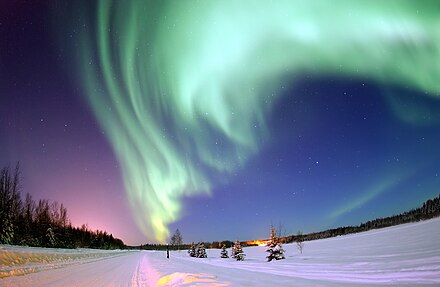Boreal forest
Boreal forest
The boreal forest (also called "taiga", "the subarctic" or "near north") is a huge region stretching across the middle latitudes of North America and Eurasia. It includes everything north of the temperate grasslands and broadleaved forests but south of the true Arctic.
Cities
- Arkhangelsk - 350,000 people, and major Russian seaport
- Irkutsk
- Yekaterinburg
- Fairbanks
- Sudbury - 161,531 people, nickle mining capital of Northern Ontario
- Fort McMurray
- Thunder Bay
- Duluth
- Sault Ste. Marie - twin cities on either side of St. Mary's River which connects Lake Superior and Luke Huron, with 73,368 in Ontario, Canada, and 13,552 in Michigan, USA
- Sundsvall
- Tampere
- Saguenay - population 145,949 (2016), the seventh largest city in Quebec, located where the forest is penetrated by a fjord leading from the St. Lawrence River
- Petropavlovsk-Kamchatsky, around 200,000 people, the largest city of the Kamchatka Peninsula in the Russian Pacific
Other destinations
- Wood Buffalo National Park, together with neighbouring parks, forms the largest patch of protected boreal forest in the world, also home to the Peace-Athabasca Delta, the world's largest inland freshwater delta.
- All Finnish national parks are at least partly in the Boreal forest zone.
- The Pole of Cold is the coldest place in the Northern Hemisphere, in Yakutia, Russian Far East.
Understand

This is a vast band of forests that ring the globe. It's too cold here for most leafy trees, so spruces, pine and larch dominate (varying between regions). It's so cold that the fire season is short, and fires are spaced many years apart, giving trees time to compete with grasses.
Water evaporates slowly here, and tends to collect from year to year in every available depression. There are literally millions of lakes across the subarctic.
Soils are generally poor and the growing season is short, so agriculture is limited but does thrive in small belts. The main lifestyles of most peoples indigenous to this region are hunting, trapping, gathering, and fishing. Forestry has been important for the last centuries in some regions – and in recent decades mining and hydroelectricity generation has spread to many previously roadless locations.
Some parts of the world that were once part of this vast forest have been almost completely deforested in recorded history, so the descriptions above no longer seem to fit, but are included on the map to the right. This applies to much of Scotland and Iceland.
Get in
Road connections are almost entirely from the south. As a general rule, the further north one goes, the more one relies on air and sea travel to get to the region.
Get around
By car
See also: Winter driving
See also: Driving in Canada
If one happens to be travelling by road, planning the route is crucial, as it is often hundreds of km between fuel and food stops.
In this part of the world, it's also not uncommon to travel by canoe, dog sled, snowshoe, or cross-country skis. While hiking in the wilderness is one of the best reasons to come here, it will often be near a city or highway. As anywhere, hiking farther in the wilderness requires planning and experience, but in the Nordic countries it is easy to access routes with few people and seemingly untouched nature, but still find huts or lodges for most nights.
See
 Watch the northern lights (aurora borealis) dance in the sky on a dark evening. Depending on latitude and season, you may also be able to see the midnight sun.
Watch the northern lights (aurora borealis) dance in the sky on a dark evening. Depending on latitude and season, you may also be able to see the midnight sun.
Observe wildlife (North American wildlife or Eurasian wildlife), enjoy birdwatching or wildlife photography, or go fishing or hunting. Try being truly alone, and experience what silence really sounds like.
Itineraries
Russia's Kolyma Highway, Canada's Mackenzie Highway, the Alaska Highway shared between Canada and the USA, and Highway 4 (Finland) are long-distance itineraries in this region.
Do
Eat
Eat what the local indigenous people eat (the local wild game and forest plants and mushrooms), or be willing to pay the shipping costs involved in bringing farmed produce all the way up here.
Drink
Stay safe
See also: North American wildlife
Go next
To get to the Arctic, you can take the Dalton Highway in Alaska or the Dempster Highway in Canada, either of which will bring you to the shores of the Arctic Ocean. The European routes E6, E45, E8 or E75, or Russian M-18, will likewise take you to the Arctic, through significantly more densely but still sparsely populated regions. Much travel to and in that region is by boat or aircraft, as the population often is too sparse to warrant the effort of building roads.